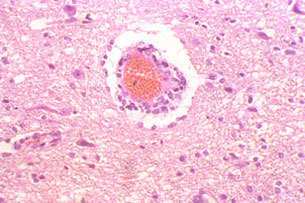
Differential diagnosis is carried out on diseases in which skin lesions are easily mistaken for those of African Swine Fever. The most important differential diagnoses are Classical Swine Fever, Swine Cholera, Erysipelas, acute Salmonellosis and Aujeszky's disease orPseudorabies and the Porcine Dermatitis-Nephropathy Syndrome.
| Table 1: Signs and lesions that are differential with ASF | |||||
| Disease | Affected species | Signs | Lessions | ||
| Coinciding | Differential | Coinciding | Differential | ||
Classical Swine Fever |
Pigs | Fever, depression |
Longer clinical course than ASF |
Cutaneous and renal haemorrhaging, and in the lymphatic ganglia. |
Ulcers in the caecum and colon, marginal infarct in the spleen (Fig.39), pale renal parenchyma, non-purulent meningoencephalitis. |
| Acute salmonellosis (S.cholerasuis) |
Pigs | Swine Fever, abortions. | Yellowish liquid diahrroea, low morbidity and high mortality. | Cyanosis on the tips of the ears, tail, trotters and abdomen, haemorrhaging in the renal cortex, splenomegaly. | Focal hepatic necrosis, serous or necrotic enterocolitis. |
| Erysipelas (Swine Erysipelas) |
Pigs | Swine fever. | Chronic forms of arthritis. | Splenomegaly, petechiae in the renal cortex, ganglionar hypertrophy with tumefaction and haemorrhaging. Romboid urticariform lesions on the skin. | Arthritis and vegetative endocarditis. |
| Dermatitis-nephropathy syndrome | Pigs | (See lesions) | Non-specific, slight hyperthermia, weakness | Purple-red marks on the skin of the hams, ears, abdomen and perineum. | Renal petechiae. Lesions caused by necrotising vasculitis. Pale kidneys despite petechiae. |
| Aujeszky´s disease. | Pigs, ruminants, rodents and carnivores. | Abortions (Fig. 42), cutaneous cyanosis in piglets. (Fig.43) |
Nervous signs | Pneumonia. | Necrotic enteritis. |
| Table 2: Signs and lesions according to the virulence of the isolate. | ||||
| ASFV virulence |
Incubation period |
Clinical course | Clinical signs | Mortality |
| High virulence | 2-3 days | 1-4 days | Sudden death with no signs of encephalitis or fever, prostration, skin alterations. | 90-100% |
| Moderate virulence | 2-3 days | 7-20 days | Typical signs of ASF: fever, prostration, lack of appetite, skin alterations. Abortions and high mortality in mothers. |
> ó = 60% |
| Low virulence | 2-3 days | 15-21 days | Multifocal cutaneous necrosis, painful inflammation of the carpus and tarsus. Abortions. Seroconversion. It may be inapparent. |
< ó = 10% |

Fig. 40: Classical Swine Fever.
Brain. Perivascular cuffing
in non-purulent meningoencephalitis
characteristic in CSF.